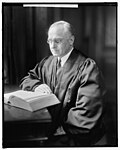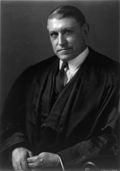Korematsu v. United States
Korematsu v. United States 323 U.S. 214 (1944), was a landmark United States Supreme Court. It concerned the constitutionality of military commanders, under an executive order by the President, which ordered Japanese Americans into internment camps during World War II.[1] This was regardless of their citizenship.[1] In February of 1942, President Franklin Roosevelt issued Executive Order No. 9066.[2] This gave military commanders the power to evacuate all persons considered a threat to national security from the West Coast of the United States to relocation centers.[3] Fred Korematsu, a Japanese-American who was born in the United States, refused to comply with the order.[3] He became a fugitive, but was arrested and sentenced to five years probation.[4] He appealed his conviction with the Ninth Circuit Court of Appeals. After having his conviction upheld, the case was heard by the U.S. Supreme Court. In a 6-3 decision, the Court upheld his conviction and ruled the exclusion order was constitutional.
| Korematsu v. United States | |
|---|---|
 | |
| Argued October 11–12, 1944 Decided December 18, 1944 | |
| Full case name | Fred Korematsu vs. United States |
| Citations | 323 U.S. 214 (more) 65 S. Ct. 193; 89 L. Ed. 194; 1944 U.S. LEXIS 1341 |
| Prior history | Certiorari to the Circuit Court of Appeals for the Ninth Circuit |
| Holding | |
| The exclusion order leading to Japanese American Internment was constitutional. | |
| Court membership | |
| |
| Case opinions | |
| Majority | Black, joined by Stone, Reed, Douglas, Rutledge, Frankfurter |
| Concurrence | Frankfurter |
| Dissent | Roberts |
| Dissent | Murphy |
| Dissent | Jackson |
| Laws applied | |
| Executive Order 9066; U.S. Const. amend. V | |
Decision
The question before the Court was did the President and Congress exceed their long powers. Did they violate the rights of Japanese and American citizens of Japanese descent?
In the majority opinion by Justice Hugo Black, the Court ruled 6-3 that the need to protect the country from espionage outweighed the rights of Mr. Korematsu.[5] The issue of discrimination against a person due to prejudice against his ancestry is not a factor.[5] Neither is there any question of his loyalty to the United States.[5] The sole issue is his refusal to comply with a legal order during a time of war.[5]
Background
On May 19, 1942, during World War II, Japanese Americans were ordered to be move into relocation camps by Civilian Restrictive Order No. 1, 8 Fed. Reg. 982. This order, and other similar orders, were based upon Executive Order 9066 (February 19, 1942). Fred Korematsu was a Japanese-American man who decided to stay in San Leandro, California and knowingly violated Civilian Exclusion Order No. 34 of the U.S. Army. Korematsu argued that the Executive Order 9066 was unconstitutional and that it violated the Fifth Amendment to the United States Constitution. He was arrested, tried and convicted. No question was raised as to Korematsu's loyalty to the United States. The Circuit Court of Appeals affirmed the conviction, and the Supreme Court granted certiorari.
Effects of Korematsu
The decision in Korematsu v. United States has been very controversial. Korematsu's conviction for evading internment was overturned in 1983.[6] He received the Presidential Medal of Freedom in 1998 from President Bill Clinton.[6]
Korematsu V. United States Media
Japanese American Assembly Center at Tanforan race track, San Bruno
References
- ↑ 1.0 1.1 "Korematsu v. United States". CaseBreifs. Retrieved 21 March 2016.
- ↑ "Document for February 19th: Executive Order 9066: Resulting in the Relocation of Japanese". The National Archives. Retrieved 21 March 2016.
- ↑ 3.0 3.1 "Korematsu v. United States (1944)". PBS. Archived from the original on 19 March 2016. Retrieved 21 March 2016.
- ↑ "Korematsu v. United States". Densho. Retrieved 21 March 2016.
- ↑ 5.0 5.1 5.2 5.3 "Mr. Justice BLACK delivered the opinion of the Court" (PDF). C-SPAN/National Cable Satellite Corporation. Archived from the original (PDF) on 17 April 2016. Retrieved 21 March 2016.
- ↑ 6.0 6.1 "Korematsu V. United States". C-SPAN/National Cable Satellite Corporation. Retrieved 21 March 2016.






